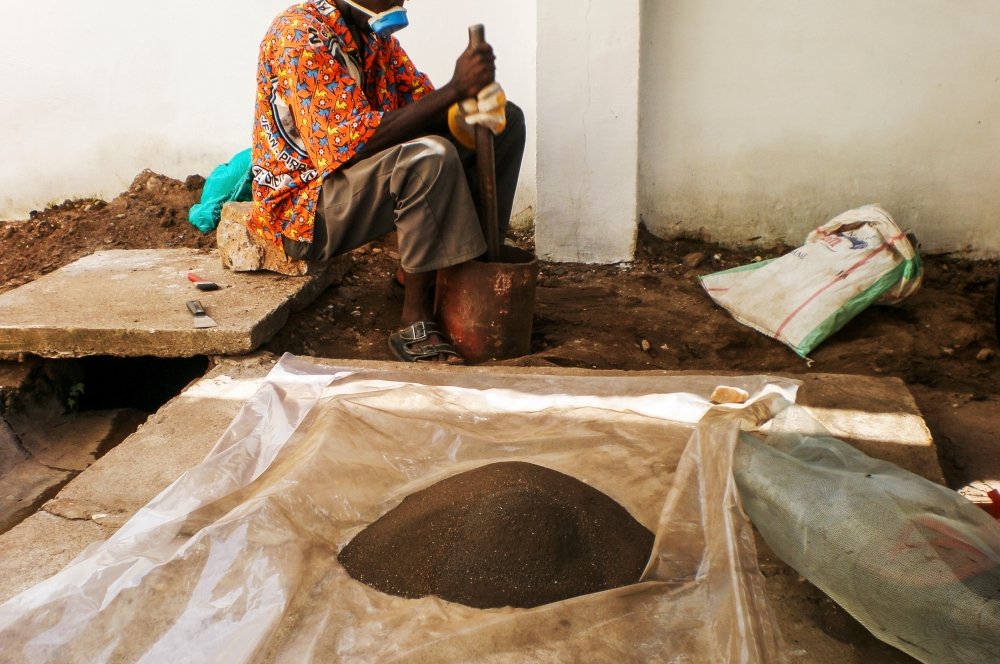By Lauren Herzer Risi & Claire Doyle on July 18, 2023

IMAGE CREDIT
This blog was originally posted on NewSecurityBeat, a blog of the Environmental Change and Security Program at the Wilson Center.
The increased demand for minerals driven by the renewable energy transition has put China’s involvement in mining activities in Africa in the spotlight. But understanding the challenges posed by this activity means we need to situate it within broader contexts.
First, there is the overall global legacy of resource extraction. Chinese companies are not alone in having a poor record on environmental and human rights abuses. This is particularly the case in Africa—where colonial powers and transnational mining companies wreaked havoc during much of the 19th and 20th centuries.
Even in contemporary settings, extractive industries continue to exact a high price on local communities in places where social and environmental safeguards are lacking or not enforced. Regardless of the urgency of the climate crisis and the importance of minerals to power a clean energy future, this is a point that cannot and should not be ignored. All actors working in this space must do better.
It’s also worth noting that while Chinese investments in Africa are significant, Chinese mining companies represent only 8 percent of Africa’s total output in the sector. Anglo-American alone accounts for more than double that share. “We have a tendency to inflate the importance of the Chinese in the mining sector [in Africa],” said Eric Olander, co-founder of the China-Global South Project, at a recent event hosted by the United States Institute for Peace.
Olander also said that using the broad terms “Africa” and “China” can sometimes be misleading. Referring to “Africa” can obscure vast differences across the continent—including in terms of countries’ engagement with Chinese companies. “‘Africa’ flattens this very large and diverse continent,” he said. The Chinese mining presence in Africa is concentrated in just five countries: Guinea, Zambia, South Africa, Zimbabwe, and the Democratic Republic of the Congo (DRC). Similarly, it’s overly simplistic to assume that Chinese companies act on the orders of their government—or that there isn’t a diversity in approach across China’s mining operations.
On the evidence, however, China is the top destination for minerals exported from Africa. In 2019 alone, mineral exports from Sub-Saharan Africa to China reached $10 billion. And China’s presence in Africa’s mining sector involves entities associated with bad practices. So what are the most specific areas of concern—and how can they best be addressed?
This question is made more urgent because China has a 20-year head start on minerals in Africa. A 2019 New America report articulated clearly how China aligns its trade, investment, and national engagement strategies with strategic resource-rich countries. The United States is playing catch up. And when John Podesta addressed a question about working with mineral-producing countries at a recent Wilson Center appearance, one of the main thrusts of his response was that the United States needs to start by showing up.
Assessing Labor and Human Rights Abuses
The prevalence of child labor in mining is at the forefront of any discussion of labor and human rights in this sector. And China’s investments in the DRC, where more than 40,000 children work in artisanal cobalt, lithium, and REE mining, have only exacerbated child labor issues.
At a congressional hearing in 2022, a prominent Congolese civil rights attorney testified that children are working at mines—like the Kasulo deposit—that are owned or effectively operated by Chinese companies. Children work seven days a week and for more than 12 hours a day, using rudimentary tools. They are also exposed to radioactive minerals, injuries, and disease.
Yet the problems are both deeper and more pervasive. There is also a prevalence of worker safety and pay violations, including threats of violence for speaking up. Research done by the UK NGO Rights and Accountability in Development found that workers at Chinese-owned mines in the DRC have faced discrimination almost daily – including physical violence and verbal abuse.
The Rights and Accountability report specifically mentions the deep indignities forced upon workers there, including “a “colonial era” level of discrimination—being kicked, slapped, beaten with sticks, insulted, shouted at, or sometimes pulled around by their ear, when they were not able to understand instructions in Mandarin, made errors or refused to undertake dangerous tasks.” The report goes on the note that most of the people who spoke up in response were dismissed without pay.
And after one mine in the DRC was bought by a Chinese company from an Arizona-based entity in 2016, employees said that worker safety had declined dramatically and that workers had been assaulted after raising concerns.
Zimbabwe offers another example of these practices. Africa Daily has reported the extensive ill-treatment of local workers by Chinese-run mining companies. This exploitation includes extremely low wages and delayed payments (sometimes for several months), poor food and living conditions, and being forced to work without protective equipment.
There is also retaliation and harsh consequences for those who try to assert their rights. The Zimbabwe Environmental Lawyers Association says that in the context of Chinese mining operations, “if a worker attempts to assert their rights and demand what is fair, they risk being shot or beaten.”
Accelerated Environmental Degradation
By its very definition, mining is going to have an impact on the environment. But while there has been progress in extractive technologies and environmental safeguards, Chinese companies often don’t carry out adequate environmental impact assessments or uphold those safeguards.
The result? There is deforestation and habitat destruction as forests are cleared to make way for mining infrastructure. Water contamination is also an issue. Improper handling of mine tailings and wastewater often means the release of toxic substances into rivers and streams that local communities depend upon.
Mining activities can also lead to soil erosion and degradation—as well as reduced agricultural productivity in surrounding areas. And a lack of air quality control measures means that air pollution and dust emissions, including fine particulate matter, can have adverse effects on community health and the surrounding environment.
Such impacts often outlive the mine itself. In the Central African Republic (CAR), for example, Amnesty International reported that in the wake of the departure of four Chinese gold mining companies in 2020, seven people died at the abandoned mining sites. The Ouham River, a source of food and water for the local community, was dangerously polluted with mercury due to mining-related contamination.
Getting a Grip on Governance
In many of the places where critical minerals are found and mined, governments struggle with weak institutions, corruption, and ongoing conflict dynamics. This weakness complicates their ability to ensure that mining operations benefit local communities—as well as keep track of mining company and operator compliance with existing legislation. Many of the communities in which these resources are located also lack access to essential health services, education, and employment.
Chinese investors and operators have been heavily criticized both for inadequate investment in local development and for undermining local employment. Research published by the German Institute of Global and Area Studies found that while non-Chinese mining operations are associated with higher employment rates in surrounding areas, proximity to Chinese-controlled mines was not shown to lower unemployment risk.
The DRC offers an example of how these dynamics play out. Mining sector investments and exports are key drivers of its growth, and yet that nation is ranked among the top five poorest countries in the world. (In 2022, 62 percent of the DRC population lived below the international poverty line.) The country also has a long history of conflict and instability and an ongoing humanitarian crisis. Its first peaceful transition of power after 62 years of independence came in 2019. There has been progress, yes, but insecurity persists in some parts of the country.
The complexity of mining operations and the fluidity of mine ownership also complicate tracking and enforcement. Improving transparency across the supply chain is a key consideration for the US and its partners in tackling governance issues. One cannot take action without knowing the actors involved.
Showing Up and Making a Difference
More and more, there is a recognition that climate change is shaping our future. But population trends are also changing. Populations are more mobile and urbanized than ever. There is aging in some parts of the world, and there is a high proportion of youth in other regions. As the renewable energy transition shifts investments and trade, how we prepare for shifting population trends will determine how sustainable, equitable, peaceful, and prosperous our future is.
Africa will play an outsized role in these discussions. The global population has now reached eight billion—nearly double what it was in 1980. But over the last several decades, population trends have shifted. Africa is now the last remaining region with a rapidly growing population. It’s also the most rapidly urbanizing part of the world and the least energy-consuming region per capita. And the continent is on the frontlines of climate change.
In a forthcoming Wilson Center paper, Jack Goldstone and John May write that between 2020 and 2040, the world’s population of 15-to 49-year-olds will increase by 428 million. Of this number, 420 million will be African—accounting for 98 percent of global net labor force growth. That’s an astounding number.
Goldstone and May also argue that investments in education and providing African countries with the financing and technology to achieve clean development mean that Africa’s youth could transform the global economy. Which raises the question of what opportunities exist to show up and do better in Africa’s mining sector.
Investments in this sector (among others) can create co-benefits in employment and revenue generation, infrastructure, education, technology transfer, peace, and security. In mining, these opportunities seem especially clear: Minerals needed for the renewable energy transition are mined in 70 countries where USAID has a presence. A path exists for the United States to show up and leverage tools across agencies, as well as partner with private industry, country leaders, and civil society, to meet global demand and ensure its benefits are felt at the local level.
Mining investments are long-term investments. With the right guardrails and protections, they can support development while minimizing harm. And African governments are beginning to demand more. Through the Minerals Security Partnership, the Partnership for Global Infrastructure and Investment, and the Energy Resource Governance Initiative, there has been progress in US policy, but we have a ways to go. In a recent policy brief, the Wilson Center’s Sharon Burke and Claire Doyle articulated some key recommendations.
US mining investments on the continent should go beyond addressing core human rights, environmental, and governance concerns in the sector to address deeper structural issues. For instance, the United States should look for opportunities to partner in ways that create value-added processes within sourcing countries, as well as support livelihood diversification programs to build resilience to market shocks within mining communities. Scale is also crucial. While governance schemes across the globe tend to heavily favor large-scale mining, the US can play a role in promoting regulatory regimes and policies that build cooperation between large-scale mining and artisanal and small-scale mining. Policymakers can also urge that the U.S. build on current policies and programs that seek to eliminate child labor in the mining industry and provide alternative income opportunities.
It is easy to point out the problems with China’s presence in Africa’s mining sector. US policy is being shaped now in many ways as a response. But let’s not forget that the US and China also have a shared interest in a reliable and affordable global supply of critical minerals. As we formulate and implement policies to improve US presence in the sector, we should also continue to look for ways to cooperate with China to raise global standards.
Sources: African Business, Amnesty international, Business Standard, Energy Resource and Governance Initiative, German Institute of Global and Area Studies, IPIS, Minerals Security Partnership, Republic World, Rights and Accountability in Development, The White House, The World Bank, United States Institute of Peace, The New York Times, US Congressman Chris Smith., Tom Lantos Human Rights Commission.
Photo credit: A Congolese man grinding coltan ore, courtesy of Nada B/Shutterstock.com.
ABOUT THE AUTHORS

Lauren Herzer Risi
Program Director, Environmental Change and Security Program

Claire Doyle
Program Assistant, Environmental Change and Security Program
ENVIRONMENTAL CHANGE AND SECURITY PROGRAM
The Environmental Change and Security Program (ECSP) explores the connections between environmental change, health, and population dynamics and their links to conflict, human insecurity, and foreign policy. Read more
AFRICA PROGRAM
The Africa Program works to address the most critical issues facing Africa and U.S.-Africa relations, build mutually beneficial U.S.-Africa relations, and enhance knowledge and understanding about Africa in the United States. The Program achieves its mission through in-depth research and analyses, public discussion, working groups, and briefings that bring together policymakers, practitioners, and subject matter experts to analyze and offer practical options for tackling key challenges in Africa and in U.S.-Africa relations. Read more
No comments:
Post a Comment